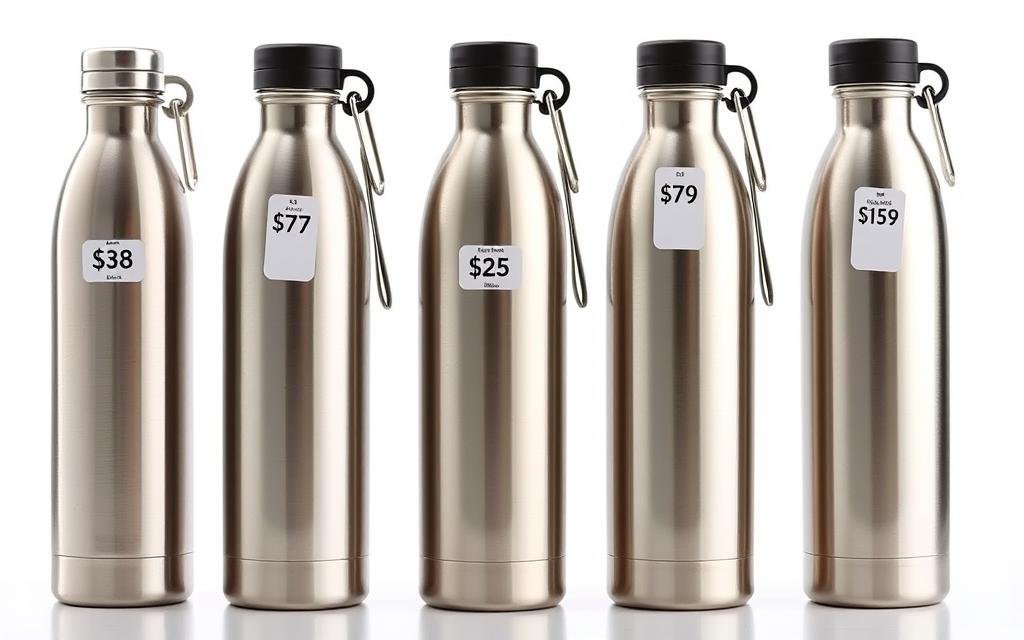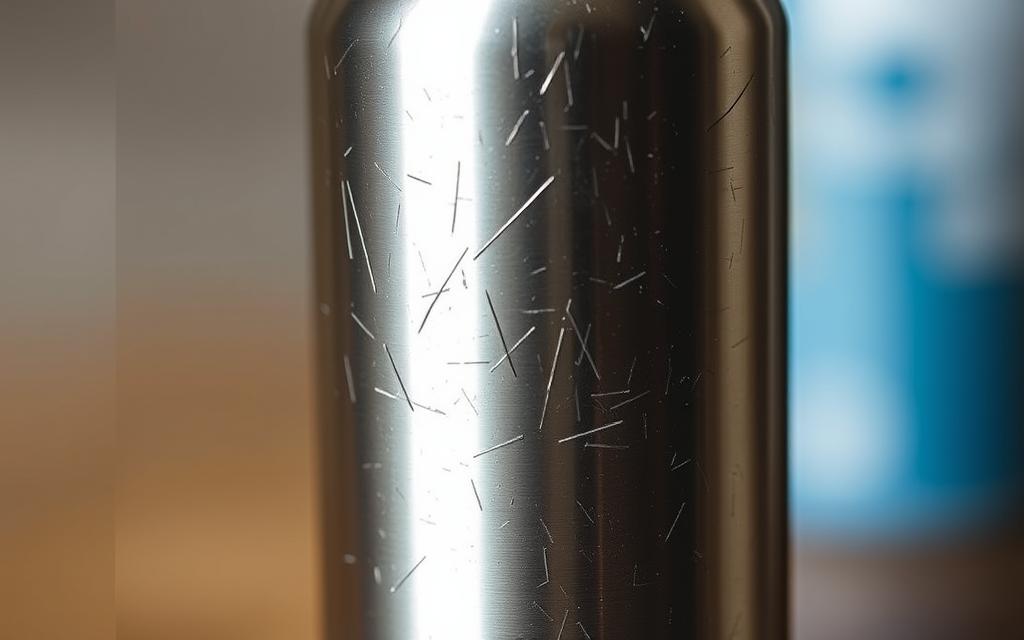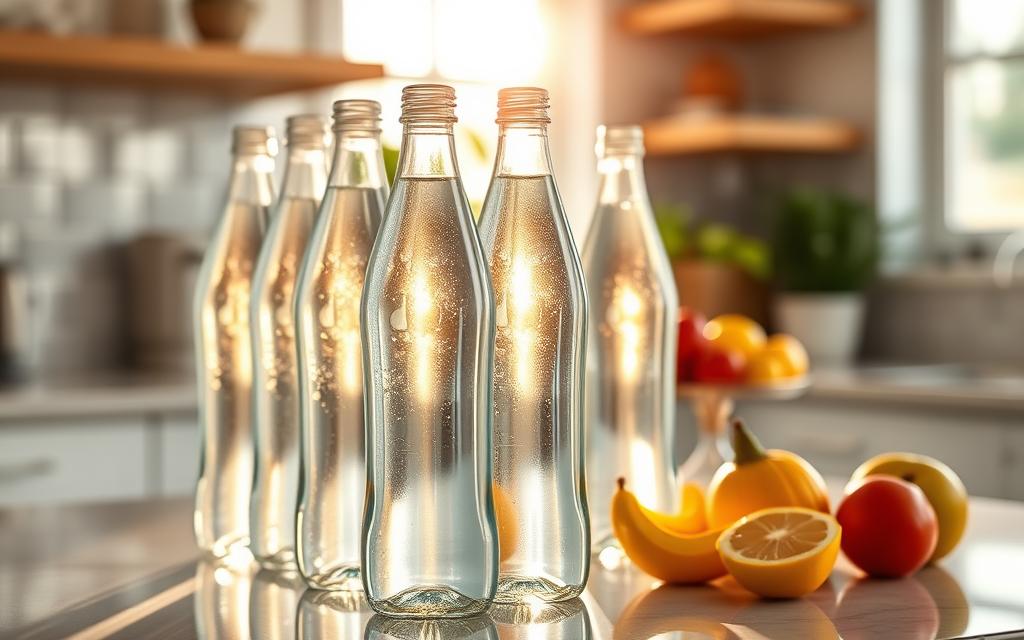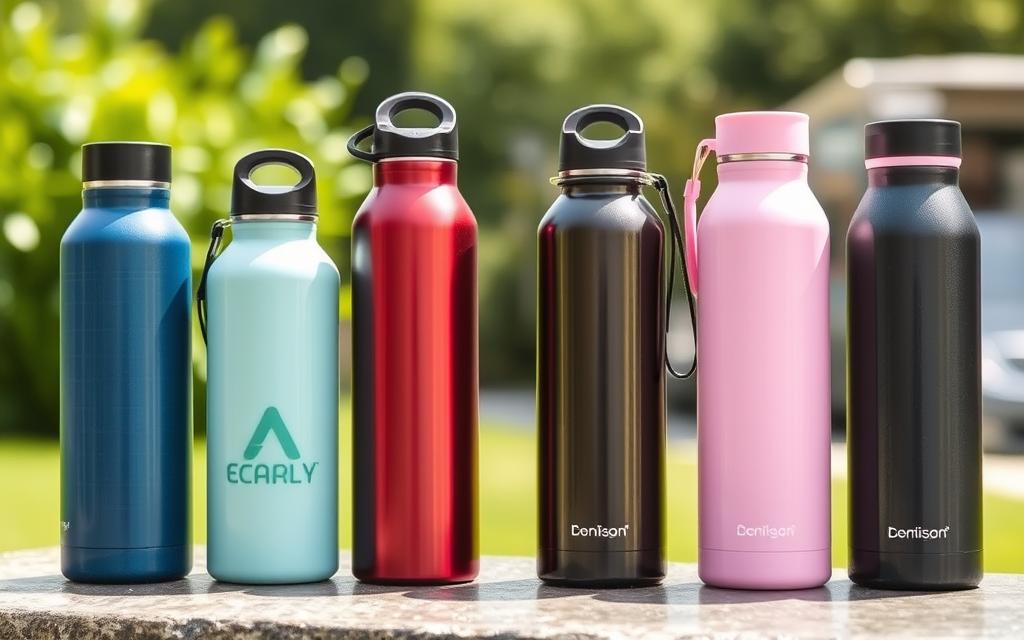Ever thought your stainless steel water bottle might not be the best choice? These bottles are popular for being healthy, but they have surprising downsides. I’ve looked into many reusable water containers and found the issues with stainless steel bottles that you might not know about.
Stainless steel water bottles are everywhere, promising to last long and be good for the planet. But, they have problems that might make you think twice. What are the real issues with stainless steel water bottles that could change how you drink water every day?
In this detailed guide, I’ll share the hidden problems with stainless steel water bottles. You’ll learn about unexpected costs, practical issues, and more. This will help you choose the right water bottle for you.
Key Takeaways
- Stainless steel water bottles have significant hidden drawbacks
- Cost can be substantially higher than alternative materials
- Weight and portability present real-world challenges
- Potential for metallic taste affects drinking experience
- Maintenance and cleaning require extra effort
High Initial Cost Compared to Other Materials
When I first looked into stainless steel water bottles, the price was a big surprise. The high cost of stainless steel bottles is clear from the start. This can be a big issue for those who are careful with their money.

Budget Considerations
Let’s look at why stainless steel bottles cost more:
- Premium material costs
- Advanced manufacturing processes
- Higher durability requirements
- Quality control standards
Stainless steel bottles usually cost between $15 and $40. Plastic bottles, on the other hand, are cheaper, ranging from $5 to $15. This price gap can be a big deal for those on a tight budget.
Long-Term Investment
Even though they cost more upfront, stainless steel bottles have some great benefits. Durability is a big money-saver. They last much longer than plastic bottles, which can save you money in the long run.
| Bottle Type | Average Cost | Estimated Lifespan | Long-Term Value |
|---|---|---|---|
| Plastic Bottle | $5-$15 | 6-12 months | Low |
| Stainless Steel Bottle | $20-$40 | 3-5 years | High |
My advice? See a stainless steel bottle as a smart investment. It’s worth the extra money for quality, sustainability, and lasting use. The benefits often make the initial cost worth it.
Weight and Portability Issues
Stainless steel water bottles have unique challenges that affect their everyday use. Their weight and portability are major drawbacks. Unlike light plastic bottles, stainless steel ones are much heavier.
Heftier Than Plastic: A Weighty Consideration
The main issue with stainless steel bottles is their density. A full bottle can feel much heavier than plastic ones. This extra weight is noticeable during:
- Long hiking trips
- Daily commutes
- Fitness activities
- Travel scenarios
Best Use Cases for Stainless Steel
Despite the weight, stainless steel bottles are great in certain situations. They’re perfect when durability matters more than being light. Here are some good uses:
- Outdoor workouts
- Camping and rugged adventures
- Office environments
- Home and gym use
“Not all water bottles are created equal – sometimes weight is a worthwhile trade-off for quality and durability.” – Hydration Expert
When picking a water bottle, think about what you need. The extra weight might be small compared to the bottle’s better insulation and lasting performance.
Thermal Conductivity Challenges
Stainless steel water bottles face unique thermal challenges. These challenges can affect their practical use. Many people like these bottles for their durability. But, the thermal conductivity of stainless steel has some drawbacks.
My experience with stainless steel water bottles shows several issues with temperature management. The material’s heat transfer properties can make handling uncomfortable.
Hot Contents and Handling Difficulties
Stainless steel bottles can get very hot when filled with hot beverages. This means:
- Surface temperatures can reach uncomfortable levels
- Risk of burning hands when holding hot drinks
- Potential need for additional protective sleeves
Insulation Effectiveness Challenges
Despite claims of excellent insulation, stainless steel bottles have nuanced performance characteristics:
| Temperature Condition | Performance Rating | Potential Issues |
|---|---|---|
| Hot Beverages | Moderate | Quick heat dissipation |
| Cold Drinks | Good | External condensation |
| Extended Storage | Variable | Temperature fluctuations |
Understanding these thermal limitations helps consumers make informed decisions about their water bottle selections.
Limited Design Options and Styles
Stainless steel water bottles have their own set of challenges when it comes to style. They are durable, but their design is limited. This means most people can’t find a bottle that matches their personal taste.
The design of stainless steel water bottles has its downsides. Traditional models usually have:
- Minimalist metallic finishes
- Limited color variations
- Predominantly industrial aesthetic
- Fewer decorative options compared to plastic bottles
Classic Look vs. Personal Style
Many people like the sleek look of stainless steel bottles. But not everyone wants a uniform, utilitarian design. Young and fashion-forward people often look for bottles that show off their personality.
Customization Opportunities
Even with design limits, some makers offer creative ways to customize:
| Customization Type | Available Options |
|---|---|
| Color Coating | Matte, glossy, metallic finishes |
| Engraving | Names, logos, personal messages |
| Sticker Application | Removable vinyl decals |
“Design matters as much as functionality in personal accessories.” – Design Trend Magazine
Stainless steel water bottles are great for performance, but they lack in design variety. This is a big drawback for those who value style and want bottles that reflect their personality.
Potential for Metallic Taste
Stainless steel water bottles have many benefits. But, one drawback is the chance of a metallic taste. These bottles are known for being durable and safe. Yet, some people find an unexpected flavor that makes water less fun to drink.
Understanding Metallic Flavor Origins
There are a few reasons why stainless steel water bottles might taste metallic:
- Manufacturing residues from production
- Quality of the stainless steel grade
- Age and condition of the bottle
- Water storage duration
Practical Solutions for Taste Mitigation
Here are some ways to lessen the metallic taste in stainless steel water bottles:
- Thoroughly wash the bottle before first use
- Use baking soda or vinegar for deep cleaning
- Avoid storing water for extended periods
- Replace older bottles with newer models
While the metallic taste might be a small problem, most people find it goes away with good care. Choosing top-quality stainless steel bottles from trusted brands can also cut down on bad tastes.
Environmental Impact of Production
Looking into the downsides of stainless steel water bottles, we find the production process is key. Making stainless steel involves complex steps that harm our environment.
The production of stainless steel water bottles is energy-hungry. Getting and refining raw materials uses a lot of resources and pollutes the air.
Energy Consumption in Manufacturing
Stainless steel making needs a lot of energy. The steps include:
- High-temperature metal smelting
- Complex refining techniques
- Extensive industrial processing
Every step in making stainless steel uses a lot of energy and releases harmful gases.
Recycling Challenges
Stainless steel can be recycled, but it’s not easy. Recycling needs special places and a lot of energy.
Recycling stainless steel bottles faces:
- Not enough recycling places
- High temperatures needed
- Special sorting needed
Even with these hurdles, stainless steel is better than plastic bottles. Recycling properly and using new recycling tech can help lessen harm to the environment.
Difficulty in Cleaning and Maintenance
Stainless steel water bottles can be hard to clean and maintain. They have some big challenges during the cleaning process. These issues can make even the most careful users frustrated.
Scratching and Staining Concerns
Stainless steel water bottles are prone to scratches and stains. The inside and outside can get marks from daily use. This is true, even when using soft cleaning tools or storing the bottle carefully.
- Scratches can trap bacteria and dirt
- Stains may develop from certain beverages
- Surface damage impacts bottle aesthetics
Best Cleaning Practices
To keep your stainless steel water bottle in good shape, follow a careful cleaning routine. Gentle cleaning methods are key to keeping the bottle looking and working well.
| Cleaning Method | Recommended Frequency | Notes |
|---|---|---|
| Warm Water and Mild Soap | Daily | Use soft sponge, avoid harsh scrubbers |
| White Vinegar Rinse | Weekly | Neutralizes odors and removes light stains |
| Baking Soda Paste | Monthly | Deep clean for stubborn stains |
By taking good care of your stainless steel water bottle, you can avoid many problems. This way, your bottle will stay useful and look great for a long time.
Not Always Dishwasher Safe
Stainless steel water bottles need special care that many people forget. They are tough, but not as easy to clean as regular cups. Knowing how to clean and maintain them can help keep your bottle in good shape.
Many users are surprised to find that not all stainless steel water bottles can go in the dishwasher. This is one of the main drawbacks of these bottles.
Careful Cleaning Guidelines
Here are some tips to keep your stainless steel water bottle clean:
- Hand wash with mild detergent
- Use soft cleaning brushes
- Avoid abrasive scrubbers
- Dry thoroughly after cleaning
Temperature Risks
Extreme temperatures can harm stainless steel water bottles. Even though Grade 330 stainless steel can handle up to 2,000 degrees Fahrenheit, it’s best to be careful.
Pro tip: Always check manufacturer instructions before subjecting your bottle to high-temperature environments like dishwashers or extreme heat sources.
Using harsh cleaning methods can damage your bottle. It can affect its strength, insulation, and how well it works. Make sure to follow the right care steps to make your bottle last longer and work better.
Risk of Denting and Damage
Stainless steel water bottles are known for their toughness. But, they can dent and get damaged. They are stronger than plastic, but they can get hurt too.
What are the downsides of stainless steel water bottles when hit? The main worries are looks and how well they work.
Impact Resistance Explained
Stainless steel bottles are very strong. But, they can’t take every hit. Several things affect how well they resist damage:
- Material thickness affects overall durability
- Quality of manufacturing impacts structural integrity
- Frequency and intensity of drops and impacts
Cosmetic vs. Structural Damage
I’ve seen two main types of damage on stainless steel water bottles:
- Cosmetic Damage: Surface-level dents and scratches that don’t affect how it works
- Structural Damage: Big impacts that might mess up the bottle’s seal or strength
“Not all dents are created equal – some are just for show, while others can mess with your bottle’s performance.”
To keep your stainless steel water bottle looking good and working well, avoid big hits. Use protective sleeves or handle it carefully to avoid damage.
Compatibility with Certain Beverages
Stainless steel water bottles have some surprising limits when it comes to what you can put in them. Knowing these limits can help you choose better what to store in your bottle.
Challenges with Acidic Drinks
My experience with stainless steel water bottles showed some big challenges with acidic drinks. These bottles don’t work well with:
- Citrus juices
- Vinegar-based drinks
- Kombucha
- Sports drinks with high acid content
Drinks like these can change the taste of your water or cause a little corrosion over time.
Carbonation Considerations
Carbonated drinks also pose a challenge for stainless steel water bottles. The pressure from carbonation can lead to problems, like unexpected leakage. Here are some things to keep in mind:
- Potential pressure buildup
- Risk of unexpected leakage
- Potential alterations in beverage taste
Pro tip: Always check your bottle’s manufacturer guidelines before storing carbonated or highly acidic drinks. This can prevent damage or unexpected reactions.
Customer Misconceptions
Many people have wrong ideas about stainless steel water bottles. They think these bottles are perfect and won’t break. But, my own experience shows that these ideas can lead to disappointment.
It’s important to know the truth about stainless steel water bottles. This way, buyers can make better choices. Let’s look at some common wrong beliefs.
Misunderstanding Durability
Some think stainless steel water bottles can’t be damaged. But, they can get dented or scratched. The downsides of these bottles include:
- Potential for dents and scratches
- Susceptibility to extreme temperature impacts
- Possible structural weakness with repeated use
Comparing with Other Materials
Many believe stainless steel bottles are better than all others. But, each material has its own good points and bad points.
Stainless steel bottles are great for keeping drinks hot or cold. But, they might be heavier and cost more than plastic or aluminum bottles.
The key is understanding your specific needs and matching them to the right water bottle material.
Knowing these possible problems helps you choose a water bottle that really fits your needs and life.
Overall Longevity vs. Replacement
When looking at stainless steel water bottles, their long life is key. These bottles are very durable, even though they cost more at first. They can last 5-10 years with the right care, making them a smart choice for those who care about the planet.
It’s important to see the whole picture when talking about stainless steel water bottles. The high start-up cost is worth it because they last so long. Brands like Hydro Flask and Yeti even offer lifetime warranties, showing they believe in their products.
Expected Lifespan Considerations
How long a stainless steel water bottle lasts depends on a few things. How often you use it, how you clean it, and where you store it all matter. Taking good care of it, avoiding big temperature changes, and not dropping it can make it last even longer.
Cost-Effectiveness Evaluation
Buying a good stainless steel water bottle might seem expensive at first. But, it’s actually cheaper in the long run than buying disposable ones all the time. It saves money and helps the environment, making it a smart choice for those who want to save money and help the planet.



